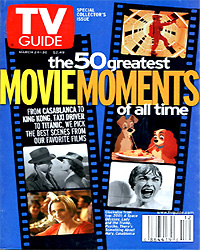
|
Movie Moments (of all-time) by TV Guide Part 4 |
For purposes of comparison, the TV Guide list includes almost all of the greatest movie moments published previously on the "Greatest Films" website, at Greatest Moments and Scenes, and at the 100 Greatest Film Scenes (in 10 parts). films that "The Greatest Films" site has selected as the "100 Greatest Films". |
TV GUIDE's
50 GREATEST MOVIE MOMENTS
(Ranked in Reverse Order)
| 12. At the time of its release, Arthur Penn's film was criticized for its violence, particularly the stunningly edited finale in which the Depression-era outlaws (played by Faye Dunaway and Warren Beatty) are ambushed and riddled with bullets. Fairly tame by today's graphic standards, the bloody ballet of death created a furor that, in part, overshadowed Penn's artistic vision. Penn's bank-robbing killers were stuck in a sad and pathetic bid for notoriety as they tried to escape the poverty of dust-bowl Texas. Midway through the film, a sense of doom descends over Bonnie and the audience as the couple's grim fate becomes clear. Yet the roadside ambush - in its brutality, loving close-ups, slow motion and, yes, strange beauty - is no less shattering for its inevitability. Penn blew away not only his antiheroes but the romance of a criminal life. |
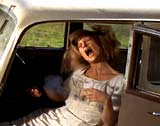 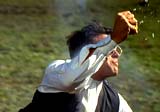
|
| 11. To gear up for his role as Travis Bickle in Martin Scorsese's searing study of alienation and psychosis. Robert De Niro spent a month driving a cab in New York City. He didn't need any on-the-job training for the movie's most celebrated scene, though: Standing before a mirror, Bickle practices his quick draw while belligerently demanding of his reflection, "You talkin' to me? Then who the hell else...You talkin' to me?" It's a stunning depiction of a disturbed soul coming unhinged. Until this point, Bickle has drifted through his dark night in a tentative fashion, dead-eyed and disconnected. As he delivers his screw-loose soliloquy, he is transformed with passion, purpose and threat. At the end of the speech, De Niro looks at the mirror and says, "You're dead." Whether he's speaking to his enemies or himself is anyone's guess. |
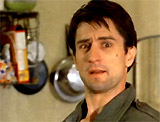
|
| 10. Titanic (1997) - THE SINKING The splashiest moment in the greatest disaster movie ever made. James Cameron's three-hour-plus, $200 million recreation of the sinking of the Titanic is the most expensive movie in Hollywood history and pays off fantastically. Say what you will about the sometimes pulpy screenplay: Cameron's scrupulous work - from his own visits to the ocean floor to the slavishly detailed replica of the fabled White Star liner - all comes together as the massive ship plunges vertically into the icy Atlantic. Technology made it look real, but Cameron's skills as a director made it feel that way. The awesome destruction and deafening cracks (especially when the ship snaps in two) are balanced with smaller touches of human tragedy (an elderly couple embracing in bed as the water rises), proving that old-time movie magic still holds a place in high-tech Hollywood. |
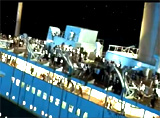
|
| 9. Packed with riotous routines, sidesplitting sight gags and hilarious one-liners, director Sam Wood's A Night at the Opera fully captures the inspired insanity of the Marx Brothers. In its wildly unruly set piece, one person after another (including Harpo and Chico, naturally), crowds into Groucho's cramped ocean-liner stateroom, squeezing every laugh from the situation. The chaos ends when the great Margaret Dumont opens the door and all aboard come pouring out. Many (if not most) of the Marx Brothers' films tried too hard to contain their anarchy. A Night at the Opera lets it spill all over the place. |
 
|
| 8. MGM really knew how to churn 'em out during the golden age of Hollywood musicals, but no other song-and-dance routine is as foot-stompingly exuberant as Gene Kelly's glorious rain dance. Pulling triple duty as the film's codirector, cochoreographer and star, Kelly hoofs his way through 14 songs, most often partnered with plucky newcomer Debbie Reynolds and rubber-limbed Donald O'Connor. Although not the movie's most elaborate number - that honor goes to the big 14-minute Broadway Melody ballet - Kelly's waterlogged tap dance to the title song remains the tour de force of this (or, for that matter, any) musical. In his tweed suit and jaunty fedora, Kelly takes to the sopping streets. With the sun in his heart, he is clearly a man in love, splashing through puddles, swinging around a lamppost and tipping his hat to an officer in blue to create one of Hollywood's best-loved moments, musical or otherwise. |
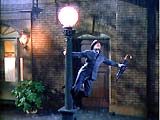
|
| 7. Is there a baby boomer alive who didn't once quake at the snide threat, 'How about a little fire, Scarecrow?" L. Frank Baum's children's story got the full Technicolor treatment when Victor Fleming set to work on his MGM adaptation, but the special effects were (at least by today's standards) a bit crude. So why does America still watch, year after year? Easy: The film's pyrotechnics take second place to its emotional truths. The long-in-coming confrontation between Judy Garland's Dorothy and Margaret Hamilton's green-faced evil one (need we mention that both actresses are splendid?) ends with a simple act of bravery - a bucket of water thrown to rescue a friend. And as a bonus, we get one of the all-time great exit lines. As the witch liquefies in a puff of steam, she laments: "Who would have thought a good little girl like you could destroy my beautiful wickedness?" |

|
| 6. Rhett Butler may not have given a damn, but audiences did and do. Even before Victor Fleming's lavish $4 million adaptation of Margaret Mitchell's best-seller, Scarlett O'Hara and her love-struck rogue were national obsessions. Casting took two years - Vivien Leigh won the role of the tempestuous belle over Bette Davis, Joan Crawford and Tallulah Bankhead, to name just a few - and even Mitchell was misguided enough to think stuffy Basil Rathbone would serve the dashing Captain Butler better than sexy Clark Gable. Good taste (or luck) won out, and the pairing of Gable and Leigh percolates for more than three hours before coming to full boil in the film's famous finale: Rhett's kiss-off to the tearful Scarlett. "Frankly my dear, I don't give a damn" closes the door on a tortured romance and Hollywood's most treasured epic. |
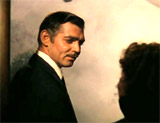
|
| 5. Director Alfred Hitchcock wanted no one allowed into theaters once the projector had started to run Psycho. Publicity stunt? Perhaps. But the master of suspense knew that timing was everything. Psycho begins as the story of an embezzling secretary (Janet Leigh) on the run. Half an hour into the movie, as rain starts to fall and Bernard Herrmann's brilliant score swells up, she pulls into the Bates Motel. A little chat with the proprietor (who seems to have a few hang-ups about Mom), and it's time for a refreshing shower. The ensuing scene lasts only 45 seconds, but its screeching violins, piercing screams and flashes of knife and skin have made motel guests and shower takers nervous for decades. And think about this the next time you draw the bathtub curtain: Hitchcock experimented - gleefully, we can imagine all too clearly - with a variety of melons before settling on the slicing sound of a nice casaba. |
 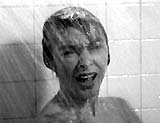
|
| 4. The greatest monster movie of its day still shouts a mighty roar. OK, so the "Eighth Wonder of the World" was an 18-inch metal model covered in rabbit fur, but Kong (he was crowned "King" only shortly before the film's release) cuts a towering figure in movie history. Like the Empire State Building itself, stop-motion animation and rear-screen projection were state-of-the-art in 1933, and the marvels helped power the adventure yarn into a blockbuster that rescued RKO Studios from bankruptcy. Nearly seven decades after the film's release, Kong's last stand atop the New York City skyscraper packs a surprising wallop, as the weary, embattled ape, releasing his beauty (Fay Wray), takes the final plunge for love. Yes, Depression-Era audiences got the erotically monumental symbolism. And yes, even today the Empire State Building always seems a bit naked without that monkey on its back. |
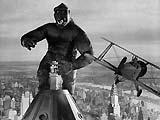
|
| 3. You could fill Little Italy with great scenes from this film, but if you have to choose one, this is it: As a rosy dawn breaks over the Hollywood Hills, a movie-studio chief, Jack Woltz (John Marley), who had rejected a deal pitched by Robert Duvall's mob consigliere, awakens in his Bel Air mansion. He notices something wet in his silk sheets. Then he sees it: blood. Throwing back the bedding, he uncovers a shocking sight - the butchered head of his priceless, favorite stallion, Khartoum. Woltz's horrified scream echoes through the mansion, a wake-up call that drops us into the savage world of Don Corleone (Marlon Brando). In that ghastly instant, we fully understand how ruthless the Mafia boss can be when his offers are refused. Animal lovers said director Francis Ford Coppola was just as blood-thirsty in his quest for perfection: The director had tried numerous props for the scene but was unsatisfied until he imported an actual horse's head from a New Jersey slaughterhouse (the blood is chocolate syrup). Coppola called the reaction absurd. "Thirty people were shot in the movie," he once said, "but people only talked about 'cruelty to animals.'" He should have taken it as a compliment. The scene was, and is, a kick in the gut. |
 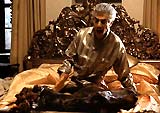
|
| 2. Bogie and Bergman will always have Paris, and we'll always have Bogie and Bergman on that foggy airfield. Firmly entrenched among Hollywood's great love stories, the Warner Bros. wartime classic was originally to have starred Ronald Reagan and Ann Sheridan as the star-crossed lovers torn apart in Nazi-occupied French Morocco. And even after director Michael Curtiz assembled the dream team of Humphrey Bogart and Ingrid Bergman on that landing strip, Bergman didn't know which of her two costars (Paul Henreid played her long-suffering husband) would wind up accompanying her on the plane to Lisbon. When it was decided that Bogart, making his debut as a romantic leading man, would shoot the mustache-twirling German general and go into hiding, more than a beautiful friendship was launched. The tough guy's "Our problems don't amount to a hill of beans" speech to the luminous, tear-streaked Bergman might be the finest statement of sacrifice ever committed to film. Here's looking at you, kid. |
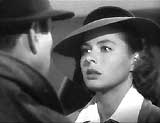
|
| 1. Saving Private Ryan (1998) - D-DAY The most wrenching, realistic combat movie ever filmed, Steven Spielberg's World War II drama did more than destroy a few Hollywood cliches: It rewrote history, changing forever the way we see our past, how we view war and how we define the word hero. Within the first 30 spellbinding, unforgettable minutes, Spielberg evokes - no, resurrects - the terror and chaos of D-Day, first with a close-up of a soldier's quaking hands as a PT boat hurtles toward Omaha Beach. What follows is a horrific sequence of hellish images - a leg blown off, a soldier carrying his own severed arm, a pile of spilled intestines. Out of the chaos emerges Tom Hanks's commander, leading a small group of U.S. soldiers taking a German bunker. When the terrible (and ingenious) cacophony of ricocheting bullets and exploding grenades finally goes silent, our sense of combat and courage can never be the same. The camera returns to the soldier's quaking hands, and we see that they belong to Hanks. Heroism, fragile and shaken, is given a human face by one of our finest actors in the finest war movie of its or any other time. |
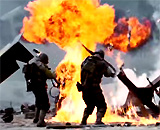 |